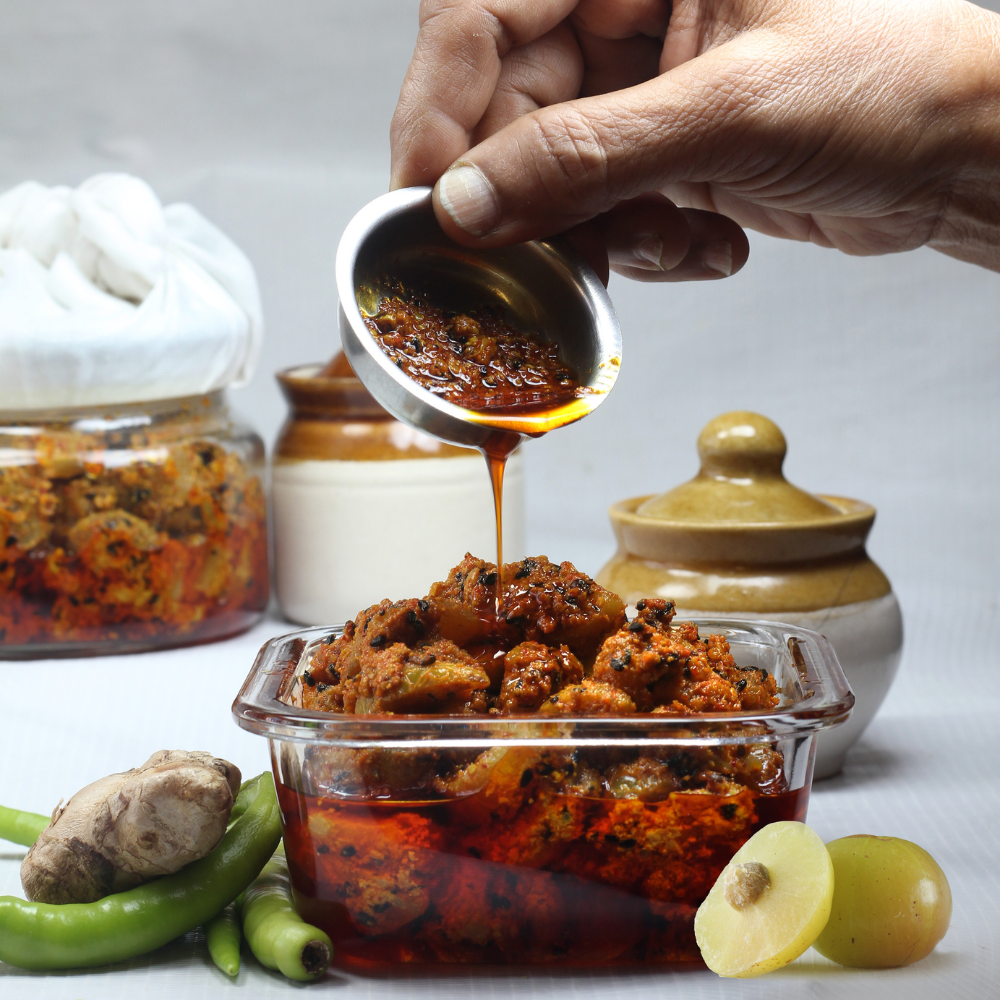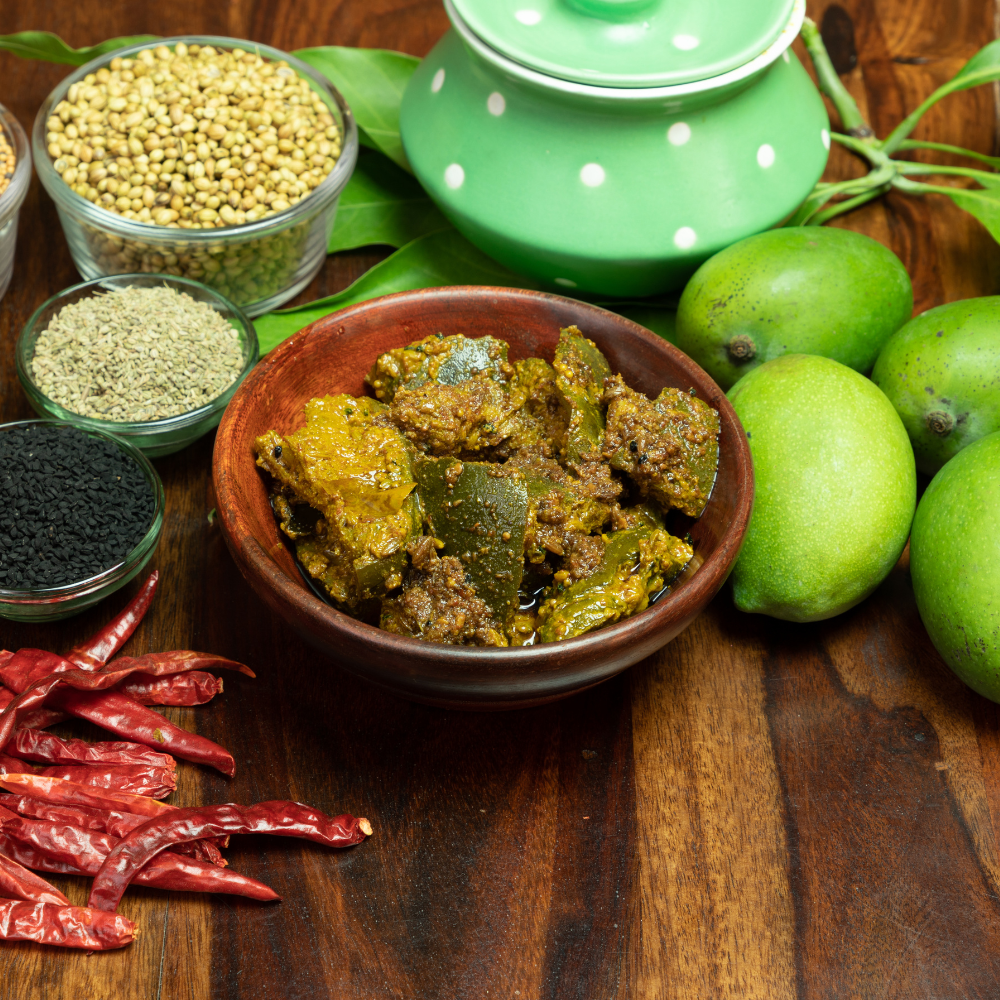When life gives you “a lemon”, you make lemonade! But,
When life gives you “lemons”, you make lemon pikles!
Lemon, just the name is enough to take you on a tangy joy ride! A fruit that is known to add a zingy flavour to any dish. A fruit that's delicious and fills you up with vitamin C and B6, iron, magnesium, calcium, antioxidants, and dietary fibres in just a spoonful. A little bit of lemon is just what you need to maintain a healthy metabolism.
The benefits of lemon are tenfold when it is pickled. The traditional method of lacto-fermentation used to pickle lemons is most effective in bringing out the best in this citrus fruit.
Let’s learn more about lacto-fermentation and how to make lemon pickles using this method.

|
Table of Contents
|
What is the Lacto Fermentation Method of Pickling?
Lacto fermentation is a food processing method used to make yoghurt, sourdough, kimchi, pickles, etc.
So, to make pickles by this method, the fruits or vegetables are dipped in a solution of salt and spices. The salty solution, or brine, helps the growth of Lactobacillus bacteria. This bacteria converts sugar into lactic acid, making it gut-friendly and a potent source of probiotics. The whole process of lacto-fermentation takes about 5 to 7 days to complete.
All of Two Brothers Organic Farm's Pickles are made using this method.
Let’s know more about lacto-fermented lemon pickle, or nimbu ka achaar.
Interesting Facts About Lacto-Fermented Lemon Pickle!

The lacto-fermented lemon pickle follows a different technique than the traditional method of pickling.
- It is oil-free.
- Lacto-fermented lemons have a unique tangy flavour and can be used to replace lemon juice in recipes.
- Lacto-fermented lemon pickle is gut-friendly and easier to digest.
- It maintains pH levels in the gut and may also improve lactose intolerance. It is a good source of probiotics.
- It can last up to a year when kept in a cool and dry place.
- It goes well with bread, naans, sandwiches, burgers, wraps and rolls.
- Lemon pickles may relieve morning sickness and nausea in some people.
- Regular consumption of lemon pickles may improve immunity.
You must be thinking, why not use the regular method of pickling to make lemon pickles as well? You can use that too!
However, this method is quick and produces a unique flavoured pickle. Here’s how to make lemon pickles using the lacto-fermentation technique.
Lacto-Fermented Lemon Pickle Recipe

Alright, to make lemon pickle or nimbu ka achaar here’s the recipe by Tarla Dalal, which takes just ten minutes of your time to make the most delicious lemon pickles of all time!
Lemon Pickle Ingredients
- 8 lemons
- ¼ cup salt
- ½ tsp turmeric powder
- ½ tsp carom or ajwain seeds
- 4 green chillies
- 50 mm of grated ginger or adrak
- 6 whole, grounded red chillies
Steps to Make Lemon Pickle
- Wash the lemons and wipe them dry.
- Cut four lemons into four pieces and squeeze out the juice. Keep the lemon pieces and the lemon juice separately.
- Cut the remaining lemons into small pieces.
- Transfer all the lemon pieces into a sterilized jar or barni.
- Take the lemon juice and mix all the spices in it: salt, turmeric, chillies, ginger, and carom seeds.
- Pour the lemon juice and spice mixture over the lemon pieces.
- Give it a good mix and press it gently with the back of a spoon to avoid any air bubbles and to make sure all the lemon pieces are covered with lemon juice.
- Cover the jar tightly and place it under the sun for a week or so, until the lemons are soft and their skin looks mushy.
- Remove the jar every evening and toss it well occasionally.
Enjoy this no-oil lemon pickle with khichadi, paratha, curd rice, etc. with your daily meals.
Here’s another recipe for lemon pickle which is made by the traditional method of using oil. Let’s check it out!

Grandma’s Recipe For Delicious Lemon Pickle
This recipe may take a little more time than the lacto-fermented lemon pickle recipe, but it turns out delicious too. It is a South Indian variation of lemon pickle that uses sesame oil and a mix of spices.
Here’s what you need to make lemon pickle.
Lemon Pickle Ingredients
- 6 to 7 lemons – large or 300 grams
- 1 tablespoon sesame oil (gingelly oil) for pan-frying lemons
- 1 teaspoon turmeric powder
- 2 teaspoons salt
- 3 tablespoons sesame oil (gingelly oil)
- 1 teaspoon mustard seeds
- 1 teaspoon fenugreek seeds
- 1-inch ginger – finely chopped
- 3 to 4 garlic cloves, finely chopped
- 1 to 2 teaspoons finely chopped green chillies
- 8 to 10 curry leaves – whole or chopped
- 1 tablespoon Kashmiri red chilli powder
- ½ teaspoon asafoetida (hing)
- ½ tablespoon white vinegar – optional
- 1 to 2 tablespoons sesame oil (gingelly oil) to be added later
Steps to Make Lemon Pickle
- Rinse the lemons in water and wipe them dry.
- Heat sesame oil on a low flame in a kadai or pan.
- Add the lemons to the pan and fry them for 2 to 3 minutes on a low flame.
- Make sure the lemons do not crack. If they start cracking, remove them from the pan. Let your pan cool down before adding them again.
- After frying, transfer the lemons to a plate and let them cool down completely.
- Chop the lemons into small pieces or as you like, and deseed them.
- Add turmeric and salt to the chopped lemon and mix them well.
- Now, add sesame oil to the pan and heat it on a low flame.
- Add mustard seeds, fenugreek seeds, chopped ginger, garlic, green chillies, and curry leaves, and fry them till the aroma of ginger and garlic goes away.
- Then, add Kashmiri red chilli powder and hing to the tempering.
- Next, add the lemons and white vinegar (optional), mix everything together, and turn off the flame.
- Let the pickle cool down completely.
- Now, transfer the lemon pickle to a clean, dry, sterilized jar or barni.
- Add the remaining sesame oil on top of it and shake it gently.
- Cover the jar with a lid and leave it for two to three days.
- Your lemon pickle is ready to be served. Enjoy!
Recipe source: Dassana Amit of VegrecipesIndia.
FAQs: How To Make Lemon Pickle?
Why is my lemon pickle bitter?
It is common to get a bitter taste in a freshly made lemon pickle. Once they mature, the bitterness goes away, leaving behind a tangy, delicious pickle. Sometimes, lemon skin and seeds can also add bitterness to the pickle. You can deseed the lemons and choose to use good-quality lemons, like the Kagzi variety, to make pickles.
Which varieties of limes and lemons are best suited for pickling?
There’s a wide variety of lemons available in India. The lemons found in different parts of the country vary in terms of taste, juiciness, structure, shape, size, and colour. For pickling, it's best to look for lemons that are juicy and have thinner skin. A few common varieties of lemons available in India are Kagazi or Jambhiri, Narthangal, Heralekai, Bijaura or Pahadi Nimbu, and Galgal that are perfect for pickling.
How long does lemon pickle last?
Lemon pickles can easily last up to a year when kept away from moisture.
What is lemon pickle good for?
Lemon has several health benefits. It improves metabolism, reduces inflammation, detoxifies the body, and provides vitamin C, B6, and dietary fibre. The intake of vitamin C improves iron and vitamin D absorption. It is also good for heart, liver, and kidney health. Lemons are also efficient at weight management.
How do I know if my homemade pickles are bad?
You can easily tell if the pickle has gone bad by looking at it. The pickle will turn discoloured and cloudy. The brine will appear dull, and there will be a possible growth of mold in it. Discard the pickle at once if there are any such signs.
Conclusion
In a world where you are constantly looking for different types of condiments, it’s always great to have as many healthy options as possible. Among all of them, pickles are the best accompaniment to make any dish scrumptious!
Lemon pickles are the most versatile pickles, as you can use them in sandwiches, salads, wraps and rolls to add a zingy flavour; or just simply enjoy them on the sides with your dal- rice, or parathas.
Lacto-fermented lemon pickle keeps the healthy bacteria in the gut flowing, aids in digestion, maintains pH and is good for skin and hair health too!
If you are looking for a ready-to-eat, healthy lacto-fermented lemon pickle don’t look further. Check out Two Brothers Organic Farms Lemon Pickle to get the authentic flavour without any added chemicals.
Read More :
How to Make Mango Pickles? (Traditional Recipes)- Complete Guide 2023










